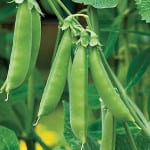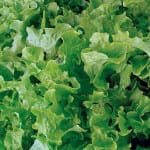By Ellen Barcel
Yes, it’s been a comparatively mild winter (just that one blizzard in January) and much of February and March has been milder than usual. My periwinkle were blooming in early March; spring bulbs were blooming by mid-March and on Easter Sunday, March 27, I saw not only forsythia in full bloom but magnolia trees as well. Yes, it’s time to get out into the garden. But, remember to be careful with what you put outside. As generally mild as it has been, we have had a few really cold days, with a coating of snow just a few weeks or so ago. Watch the weather forecasts and use a cold frame if appropriate for your new little plants.

If you can’t wait to have those fresh, homegrown veggies, there are a number that can take the cold and even prefer it. So, in early April, you can get out in the garden and get started with some of the following. As with most crops, it’s best to rotate your veggies every two or three years. This will help prevent the spread of disease and will help to fend off insects.
Peas
Traditionally peas are planted on St. Patrick’s Day or soon thereafter. So, now is ideal. Pea plants can even tolerate a light frost. Peas prefer a sandy soil. Select a location where the pea plants can climb, either a fence, trellis or other support. Don’t let the soil dry out. Make sure you add compost to the soil. Select a variety that is disease resistant and that’s about it. You’ll soon have a tasty crop that should be harvested before the heat of summer arrives. If you decide to have a second crop, you’ll have to nurse the baby plants through late summer’s heat.
There are several general types of peas: garden peas (English peas), which need to be shelled to be eaten (put the shells in your compost pile); sugar snap peas (nice and plump, with an edible pod); and snow peas, which can be used in stir fry recipes, whole. Peas mature in 55 to 85 days depending on variety.

Lettuce
While lettuce prefers a cool climate it can be kept growing all season long. Plant a new crop every two weeks. For the plants that will mature in the heat of summer, plant in a lightly shaded area. Like peas, lettuce can tolerate a light frost. There are many different varieties including head lettuce, leaf lettuce and loose head lettuce; so plant whatever you prefer. I particularly like Romaine lettuce.
Lettuce prefers a sandy but fertile soil, so add compost as needed. Using a mulch will keep down weeds and keep the soil moist and cool. For leaf lettuce, you can leave the plant growing, and just pick a few outside leaves as needed.

Radishes
Radishes grow quickly, so you can have a number of crops, planting a new row every couple of weeks. Radishes mature in 25 to 40 days depending on variety. As with most root crops, it’s best to sow seeds directly into the soil. If you try to transplant them, you’ll get some strange looking produce. Since radishes need sun, select a sunny location, and thin to about two inches apart once the seeds germinate. Radishes can be grown in pots since they are so small and can also be grown indoors year round, since you don’t want root crops to go to seed. Radishes are ideal for children just starting to garden, since they mature so quickly.
Cruciferous veggies
Cruciferous veggies (broccoli, cauliflower, kohlrabi) mature quickly. You can get two crops, if you plant one in spring and a second in mid-summer to mature in fall. You’ll get broccoli in 55 to 60 days, cauliflower in 55 to 80 days and kohlrabi 55 to 70 days. Broccoli needs full sun, as most veggies do, and can be planted two to three weeks before the last spring frost date (mid-April). It likes fertile, moist soil. Since broccoli (and other cruciferous veggies) tend to get large, you need to space your plants 12 to 24 inches apart. While some varieties are heat tolerant, all need moist soil.

Other cool weather crops include parsley and spinach (which matures in 45 to 60 days). Always read the seed package directions for maturity date, special growing instructions etc. as the above are generalities.
Ellen Barcel is a freelance writer and master gardener. Send your gardening questions to [email protected]. To reach Cornell Cooperative Extension and its Master Gardener program, call 631-727-7850.






